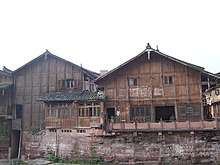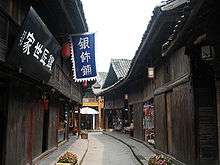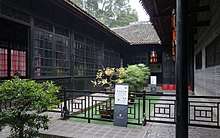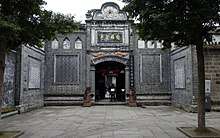Vernacular residential architecture of Western Sichuan
The vernacular residential architecture of Western Sichuan is one kind of Sichuan vernacular architecture styles in Sichuan, China. Those vernacular residential areas are located with a densely populated plain with rivers in the west of the Longquan Mountains in Sichuan basin and centered on Chengdu.[1]

Introduction

In Chinese, western Sichuan is called Chuanxi, which refers to the western plain of Sichuan and is located in the western part of the Sichuan Basin. It is also called as Chengdu Plain or Basin West Plain. The narrow western Sichuan plain refers to the alluvial plains with an area of approximately 8,000 m2 of Min River, Tuo River, and their tributaries bordered by Dujiangyan City, Mianzhu, Luojiang, Jintang, Xinjin and Qionglai.[2]
Vernacular residential architecture style in Western Sichuan became relatively mature in Qing dynasty. There are several characteristics of this architecture style which help distinguish themselves from other Chinese vernacular architecture style: it has a central courtyard to organize main rooms, several small courtyards composed to improve its inner ventilation and natural lighting, a flexible layout of corridor to connect the adjacent rooms, and amiable spaces with frequent communication, etc.[3]
Characteristics
Unique regional style

This feature is first reflected in the free form of the architectural plane. The vernacular residential buildings are characterized by courtyard as the main fundamental form. The basic unit of its composition is the courtyard, which is full of rooms at the four sides. The facade and the plane layout are flexible because there is no clear strict axis to meet symmetric requirements. There are often ventilated patios inside or behind the house to form a good draft. There are series of colonnades to arrange each room, deftly forming a neighborhood and a street. Second, this style shows a light and delicate aspect owing to its smaller architectural components. Also, in order to adapt to the hot and humid climate, most of the houses are wood-fenced structures, with a sloped roof and thin eaves.[4] Third, the residential house seems simple and elegant in terms of its light architectural color. Most of the buildings are mainly in cool colors, with gray tiles, white walls, gray bricks, dark brown beans, and brown wooden doors and windows.[1]
Integrating with the environment
The vernacular residential houses in western Sichuan can reflect the traditional Taoism concept of harmony between nature and mankind. The use of materials is in accordance with local conditions and local materials. Architecture design begins from the material properties. Materials are mainly wood, lime, gray brick, and gray tile. Those local materials are not only economical, but also very harmonious with nature, showing a mutual beauty between texture and nature.[5]
Tied with strong kinship
The compact patios and wide corridors in and around the courtyard and the corridors outside the houses along the street can be another characteristic. That public space can create a communal space for inhabitants to work and live together, improving the relationship between neighbours and strengthing their kinship.[1]
Strong compatibility

Sichuan is a multi-ethnic, multi-cultural region. According to historical data, a large number of immigrants have entered Sichuan from other provinces in succession. Therefore, the residential architecture became more compatible. Its style merged the multi-culture and finally formed its own characteristic architecture style. Meanwhile, the types of residential architecture has been enriched. Vernacular residential architecture includes not only wooden farmhouses but also manors built in stone.[5]
Causes for the formation of the architecture style
Unique natural and geographical environment
.jpg)
Sichuan Basin is surrounded by mountains, with rivers and dense small hills inside. Most of the vernacular settlements are built on the hills, mountains, and near to rivers, forming a style in a picturesque disorder. The basin has less sunshine, but more rainfall and high humidity, and it attributes to a subtropical humid climate. Due to the influence of geographical location and topography, there are rare winds in the basin. Therefore, most roofs in the Sichuan Basin are thin and light. The winter climate is warmer and the summer is hotter. In some of the common settlements, the construction ways of pavilions and halls are also formed due to the hot and rainy climate, so as to increase the permeability of the houses and facilitate the ventilation and people's outdoor activities.[6]
Rich immigration culture background
Since the Qin and Han dynasties, Sichuan's culture has gradually evolved and new external factors have been added. This has a great relationship with past immigration activities. Since the Qin defeated the Bashu, there has been a large number of immigrants to Sichuan, making the Sichuan local culture and the Central Plains' mainstream culture merge for the first time. The two times of immigration from Hunan and Guangdong at the time of the Ming and Qing Dynasties made Sichuan culture merge with a large number of cultural components and increase new vitality. On the one hand, cultures in each place are integrated with each other, making the architectural style and construction technology compatible and further developing. On the other hand, the multicultural elements of architecture coexist, which makes the basin regions have different architecture styles due to the different origins of immigrants.[6][7]
Religion and patriarchal system
As the birthplace of Taoism, Sichuan has always been influenced by the Taoist culture and Taoist aesthetics. Taoism emphasizes the aesthetic interest of respecting natural laws and rules, seeks imaginary and quiet aesthetic mindsets, advocates simplicity, admires freedom, and prefers to live the mountains away from the hustle and the bustle. These aesthetic ideals and pursuits with rich characteristics influence the aesthetic consciousness and aesthetic taste of Sichuan people in a religious and cultural form. As a substantial carrier of culture, vernacular residential architecture is a solid reflection of aesthetic thoughts and folk customs. The unique aesthetic ideas and consciousness of Taoism have profoundly influenced all aspects of residential houses in Sichuan, and have created the unique personality and artistic style of obeying the laws of nature, simplicity and elegance. The scope of Chinese traditional architectural art has been expanded in content and form.[8]
The layout of the vernacular residential houses also reflects the patriarchal ethical concepts and ritual-level thinking. Reflected in the architecture, it is the dedication and preference of the central axis. The courtyard is always located at the centerline, and the central axis runs through the entire building. The layout of the building is symmetrical and balanced, with a smooth and dignified outline, reflecting a rigorous and honest style. If there is more than one courtyard, it is generally developed along the central axis or vertically to the axis. The furniture in the hall of the house is symmetrically arranged along the central axis. The indoor core space is organized by screens and main seats inside. In the distribution of family members' rooms, it is strongly influenced by the Confucian ethics and morals, which advocates to distinguish between different hierarchy status.[9]
Types of vernacular residential architecture in western Sichuan
Mansions and manors
Mansions and manors mainly refer to the big houses where feudal officials, landlords, rich people, and literati live. The house generally follows the basic layout of the axis symmetry to reflect the family members' honorable status, but at the same time, it strives to break through this symmetry and seeks for a new form of space for the main courtyard's control to demonstrate its power and social status. Houses usually have series of courtyards, and their layout generally follows the traditional shape of "hall in front of the bedroom". Behind the house, there are gardens and affiliated courtyards.[10]
Town dwellings
.jpg)
Town dwellings are mainly divided into two forms. One is the storehouse with a combination of business and residence, and the other is the house with residential functions. The architectural materials of this kind of houses generally use local materials such as wood, brick, gray tile, stone, etc. Architectural details such as doors and windows, column foundations, etc., are exquisitely and beautifully carved. There are also forms of multiple courtyard composition, generally appearing in the houses owned by rich class.[10]
Farmhouses
Sichuan farmhouses are generally built near to the rivers and against mountains. There are generally two ways to select a site layout: decentralized and centralized. The decentralized site selection strives to avoid the pits. The riverside farmhouses are built on the northern bank near the water source but not so closed to the river. They are scattered and settled, one house corresponding to one household. Settlements of centralized site selection consist of one to twenty households. Around the farmhouses, more trees are planted to form a quiet courtyard, thus forming a natural barrier. This not only provides a good living environment for the farmers, but also forms a unique rural landscape in the plain of western Sichuan.
The farmhouses are mostly made up of courtyards. The courtyard is mainly used as an outdoor place for agricultural activities. The building materials of the farmhouse are from local materials without being painted, fully demonstrating the texture and color of the material itself. The overall architectural features are simple and rustic.[10]
Ecological enlightenments from the vernacular residential architecture in west Sichuan
Sustainable development concept
The vernacular residential architecture in western Sichuan reflects the natural concept of design and integration with nature. The modern architectural design should implement the concept of sustainable development, adjust measures to local conditions, and comprehensively consider the location, layout, and reasonable choice of architectural forms. The original terrain, vegetation and water systems should be preserved to maintain the local ecological balance. The environment should be adjusted through natural lighting and other methods suitable to the local climate in order to reduce energy consumption and achieve the symbiosis between the house and the natural environment.[11]
Making full use of the local resources
The vernacular residential architecture in western Sichuan cleverly uses local resources and draw materials locally. This saves resources, reduces energy consumption, and reduces labor costs. To build a healthy ecological living environment, we should draw on the use of traditional dwellings for resources and energy in planning and architectural design. We should use resources efficiently, avoid extravagance and waste, reduce artificial processing, emphasize recycling, and control pollution, in order to Mitigate the current situation of resource constraints.[11]
Adopting appropriate technical strategies
The choice of ecological technology in the local development and popularization is related to the ability of the region to accept this technology. Technological options that are lower or higher than the acceptability will have an adverse impact on the development of the region. Low-tech means that under the limited local conditions of resources and productivity, it is necessary to develop experience and technology in traditional buildings and improve them. Non-using or less-using high-tech means to achieve the goal of building ecology. The main adoption of low-tech with the suitable introduction of high-tech is the appropriate technology for the situation in Sichuan Basin.[11]
See also
References
- Dong, Liang; Fu, Fei (2008). "Design Strategies for Traditional Residential Areas in Chuanxi District". Urbanism and Architecture (in Chinese). 06: 80–81.
- Lu, Yin (2008). "Analysis on the Reasons for the Formation of Outward Appearance Color of Traditional Western Sichuan Common People's Residence". Journal of Sichuan College of Education (in Chinese). 24 (6): 65–66.
- Min, Shu; Yang, Chunyan (2013). "A Structural Analysing Model of Sichuan Vernacular Dwelling". In Advanced Materials Research. 663: 164–167.
- Dong, Wenying; Ding, Qifei (2014). "Roof Structure of Western Sichuan Dwelling Houses and Its Aesthetic Appreciation". In Advanced Materials Research. 889: 1329–1332.
- 归园田居. "四川的建筑特色-----川西民居". 新浪博客 (in Chinese). 新浪网. Retrieved 13 June 2018.
- Wang, Zhaoxia (2004). "The Characteristics of Traditional Folk Houses in Sichuan Basin". Chongqing Architecture (in Chinese). S1: 106–109.
- Zhang, xiaoyin (2015). 基于移民影响的巴渝传统民居形态演进研究 (MSc) (in Chinese). Chongqing University.
- Li, Xingli (2016). "浅析道教美学思想对四川民居建筑的影响". Forum on Chinese Culture (in Chinese). 09: 170–173.
- Dong, Wenying (2010). 川西民居构成形态与环境研究 (MSc) (in Chinese). Central South University of Forestry and Technology.
- Zhang, Meng (2013). 传统川西民居的符号学特征研究 (MSc) (in Chinese). Southwest Jiaotong University.
- He, Lili (2014). 四川盆地传统民居生态经验及其启示 (MSc) (in Chinese). South China University of Technology.